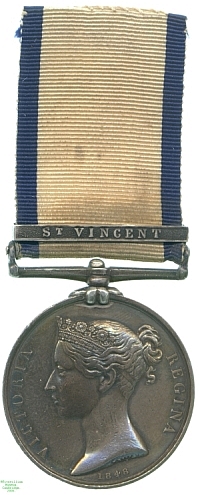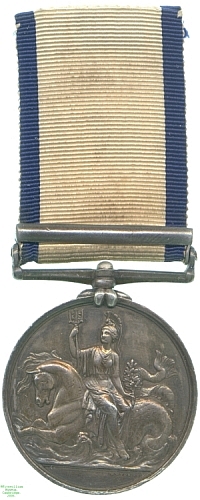
Obverse, a bust of Queen Victoria

Reverse, Britannia with a trident seated sideways on a seahorse

Obverse, a bust of Queen Victoria |

Reverse, Britannia with a trident seated sideways on a seahorse |
Just as in 1848 the extensive land campaigns of the Napoleonic Wars and the other conflicts of the pre-Victorian era were recognised by the issue of the Military General Service Medal, those serving in the Navy at the time were recognised with the Naval General Service Medal. As with the Army equivalent and the East India Company's related award, many of the battles for which the medal was awarded had been fought so long ago that few if any claimants survived.
In addition, bars were awarded for many actions whose significance and size were, despite the heroism displayed by those involved, relatively minor. The result was that many of the bars were issued in tiny numbers, with some combinations all but unique, and the medals command a very high price among collectors because of this rarity and individuality. This in turn, along with the manufacture in most cases of more bars than were eventually issued, has led to the `improvement' of many common awards where recipients' names are shared with those present at `rarer' battles. The medal also shares with the Military General Service and Army of India Medals the oddity that Queen Victoria, whose portrait they bear, was not the ruler under whom the battles for which it was awarded were fought.
In 1796 French operations in the Mediterranean began to seriously threaten the British naval position there, and when in 1797 Spain joined the Franco-Dutch alliance, it became necessary to withdraw the British Mediterranean Fleet with all speed. Admiral Sir John Jervis, with 10 ships of the line and 5 more joining from the Channel Fleet, hoped to engage the Spanish fleet in the course of a convoy operation it was conducting before joining with the French fleet, a conjuncture which would ineluctably be followed by an attempt on Britain by Napoleon.
The Spanish fleet was located off Cape St Vincent in a daring night reconnaissance by Commodore Horatio Nelson on 11 February 1797, and by 14 February Jervis had brought his ships around to engage, despite two-to-one odds against him; it is said that he considered that failure to act now would only make the odds worse. Jervis's cautious engagement was completely altered when only two ships responded to his initial signal, these being HMS Excellent and Nelson's HMS Captain. With the two third-rates engaging six Spanish battleships alone, Jervis had no option but to bring his entire force to their immediate aid. The Spanish force, under-disciplined, was unable to combine against this sudden concentration of force and Nelson's crew, abandoning the mauled Captain as irreparable, managed to capture two Spanish vessels that had become entangled, using the first, San Nicolas, as a bridge to the second, San Josef. Nelson led the charge himself, followed by some of the Marines who had previously fought for him aboard HMS Agamemnon. Capture of the Spanish flagship, Santísma Trinidad, which was then the most heavily-armed ship in the world, was subsequently prevented only by less damaged Spanish ships threatening her captain with their fire if she did not rehoist her colours. She would finally be sunk at Trafalgar.
Despite Nelson's and Jervis's heroics, which obtained the former's promotion to Rear Admiral and the latter's honouring as Earl St Vincent, the capture of four Spanish ships from a fleet of 23 was not a sweeping victory. The strength of the battle for the British was that thereafter Spanish forces were very reluctant to engage the Royal Navy, so that Jervis was able more or less to blockade the Spanish fleet in Cadiz, preventing its assistance to the French, and was able to send a squadron back into the Mediterranean in 1798 under Nelson, which then fought and won the Battle of Aboukir Bay.
This medal is inscribed to Private William Lloyd, of the Royal Marine contingent aboard HMS Orion. It has been verified that such a man did serve aboard that vessel during this engagement, but the Medals Roll suggests that his NGS Medal should carry three clasps, while two other men of this name received only the far commoner clasp for Syria. It is likely therefore that this is one of the Syria medals, retooled with a spare clasp for St Vincent to increase its value. Nonetheless, Lester Watson acquired it at some point before 1928.